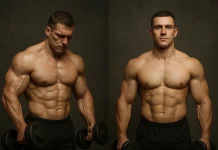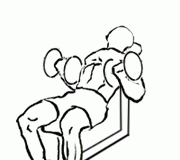Last Updated on January 17, 2025
When it comes to building muscle efficiently, the structure of your workout routine plays a crucial role. Many lifters and athletes follow structured workout splits to maximize hypertrophy (muscle growth), ensure adequate recovery, and target muscle groups effectively. In this guide, we’ll break down the best workout splits for muscle gain, who they’re best suited for, and how to implement them for optimal results.
What is a Workout Split?
A workout split is how you divide your training days across the week. Instead of working the entire body in one session, splits allow you to focus on specific muscle groups or movement patterns on different days, ensuring you give your muscles enough stimulus for growth while also allowing for proper recovery.
Key Factors for Choosing the Right Workout Split:
- Training Experience: Beginners, intermediates, and advanced lifters all benefit from different splits.
- Training Frequency: How many days per week can you commit?
- Recovery Ability: Avoid overtraining by considering your body’s ability to recover.
- Training Goals: Are you focusing on strength, hypertrophy, or endurance?
Now, let’s dive into the best workout splits for muscle gain.
1. Full-Body Workout Split (3-4 Days per Week)
Best for: Beginners, busy individuals, and those looking to maximize muscle growth with minimal training days.
How it Works:
A full-body split involves training all major muscle groups in every workout session. It’s typically performed 3-4 times per week (e.g., Monday, Wednesday, Friday). This approach allows for high training frequency without excessive volume in a single session.
Sample Full-Body Routine:
- Day 1: Squats, Bench Press, Rows, Shoulder Press, Planks
- Day 2: Deadlifts, Pull-Ups, Dumbbell Press, Lunges, Hanging Leg Raises
- Day 3: Front Squats, Dips, Chin-Ups, Romanian Deadlifts, Ab Rollouts
Pros:
- Great for beginners as it reinforces movement patterns.
- High training frequency enhances neuromuscular adaptation.
- Less risk of muscle imbalances.
Cons:
- May not provide enough volume for advanced lifters.
- Recovery can be challenging due to frequent full-body training.
2. Upper/Lower Split (4 Days per Week)
Best for: Intermediate lifters who want more focus on muscle groups while maintaining training frequency.
How it Works:
The upper/lower split divides workouts into upper-body and lower-body days, alternating throughout the week. This allows each muscle group 48-72 hours of recovery before being worked again.
Sample Upper/Lower Routine:
- Monday: Upper Body (Bench Press, Rows, Shoulder Press, Curls, Triceps Extensions)
- Tuesday: Lower Body (Squats, Romanian Deadlifts, Lunges, Calf Raises, Ab Work)
- Thursday: Upper Body (Pull-Ups, Incline Dumbbell Press, Lateral Raises, Biceps/Triceps Work)
- Friday: Lower Body (Deadlifts, Bulgarian Split Squats, Leg Press, Glute Bridges, Ab Work)
Pros:
- Allows for increased volume per muscle group.
- Great balance between frequency and recovery.
- Suitable for strength and hypertrophy training.
Cons:
- Requires 4+ days per week of commitment.
- Some muscle groups may fatigue quickly with consecutive exercises.
3. Push/Pull/Legs (PPL) Split (3-6 Days per Week)
Best for: Intermediate and advanced lifters who want optimal muscle group specialization.
How it Works:
This split separates exercises into pushing movements (chest, shoulders, triceps), pulling movements (back, biceps), and leg exercises. A three-day cycle can be repeated for a total of 6 weekly workouts.
Sample PPL Routine:
- Day 1: Push (Bench Press, Overhead Press, Dips, Triceps Extensions, Lateral Raises)
- Day 2: Pull (Deadlifts, Pull-Ups, Barbell Rows, Face Pulls, Biceps Curls)
- Day 3: Legs (Squats, Romanian Deadlifts, Leg Press, Calf Raises, Core Work)
- Repeat (if training 6 days per week)
Pros:
- Maximizes training frequency for serious lifters.
- Ensures muscle groups get adequate volume and intensity.
- Provides room for variation and progressive overload.
Cons:
- Requires a higher commitment (up to 6 days per week).
- Can be fatiguing if not structured properly.
4. Bro Split (5 Days per Week)
Best for: Bodybuilders and lifters who want maximum volume for each muscle group.
How it Works:
The bro split assigns one muscle group per day, allowing for high volume and complete exhaustion of that group. This approach is popular among bodybuilders who train for aesthetics and muscle symmetry.
Sample Bro Split Routine:
- Monday: Chest (Bench Press, Dumbbell Flyes, Dips, Cable Crossovers)
- Tuesday: Back (Deadlifts, Pull-Ups, Rows, Face Pulls, Shrugs)
- Wednesday: Shoulders (Overhead Press, Lateral Raises, Rear Delt Flyes, Shrugs)
- Thursday: Arms (Biceps Curls, Triceps Extensions, Hammer Curls, Skull Crushers)
- Friday: Legs (Squats, Romanian Deadlifts, Lunges, Leg Press, Calf Raises)
Pros:
- Allows for extreme focus on individual muscle groups.
- Ideal for advanced lifters aiming for hypertrophy.
- Provides ample recovery time for each muscle.
Cons:
- Less frequent stimulation per muscle group.
- Not optimal for beginners or those training fewer than 5 days per week.
Which Workout Split is Best for You?
| Experience Level | Best Split |
|---|---|
| Beginner | Full-Body (3-4 Days) |
| Intermediate | Upper/Lower (4 Days) or PPL (3-6 Days) |
| Advanced | PPL (6 Days) or Bro Split (5 Days) |
Key Takeaways:
- Beginners should start with full-body splits to build a strong foundation.
- Intermediates benefit from upper/lower or PPL splits for balance and progression.
- Advanced lifters can maximize volume with PPL or bro splits.
- Training frequency and volume must align with recovery to avoid overtraining.
No matter which split you choose, progressive overload, consistency, and proper recovery are the keys to effective muscle gain. Choose a split that fits your schedule and stick with it for at least 8-12 weeks to see real results.







